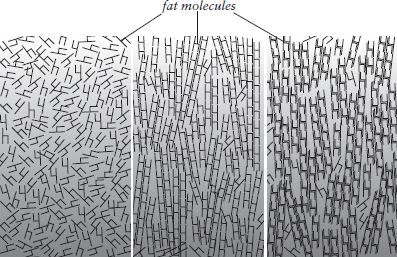Advertisement
Chocolate Flavor
By Harold McGee
Published 2004

The crystallization of cocoa butter. Left: In melted chocolate, the fat molecules of cocoa butter are in constant random motion. Center: When chocolate cools in an uncontrolled way, the fat molecules form loosely packed, unstable crystals, and the chocolate is soft and greasy. Right: When chocolate is carefully cooled, its fat molecules form tightly packed, stable crystals, and the chocolate is snappy and dry.
Chocolate has one of the richest and most complex flavors of any food. In addition to its slight acidity, pronounced bitterness and astringency, and the sweetness of its added sugar, chemists have detected more than 600 different kinds of volatile molecules in chocolate. While a handful of these may account for the basic roasted quality, many others contribute to its depth and wide range. The richness of chocolate flavor arises from two factors. One is the cacao bean’s intrinsic flavor potential, its combination of sugars and proteins, and the enzymes that break these down into the building blocks of flavor. The second factor is the complexity of chocolate’s preparation, which combines the chemical creativity of microbes and of high heat.


